Differences between Maiko and Geisha and Geiko
The main differences between Maiko and geisha (geiko) are age, appearance, and skills.
Maiko is usually younger than 20, wears a more colourful kimono with a red collar, and lacks conversation skills. Maiko means "dancing child, " referring to apprentice geisha still training. Maiko has to live in the geisha lodging house (okiya) with their mother (okami-san) for 5 years. Maiko is not allowed to have a cell phone, carry money, or have a boyfriend. Maiko on the left and a geiko (geisha) on the right, Kyoto flower tourism
Maiko on the left and a geiko (geisha) on the right, Kyoto flower tourism
What is a Maiko?
"Maiko are the apprentice geisha still training to perfect their cultural and entertainment skills. Maiko’s outfits are more eye-catching to divert attention from the lack of knowledge and experience. Geisha’s fashion is usually more mature and subtle. Maiko must live in the “mother” 's house and depend on the little stipend she receives from the geisha house. On the other hand, Geisha are more independent and live in separate houses in the geisha neighbourhoods. The images below allow you to distinguish between geisha and maiko". (Source: Geisha by Liza Dalby)
What is a Geisha (Geiko)?
Geisha are professional artists registered in official geisha associations who excel in traditional Japanese arts and crafts such as shamisen playing, dancing, and tea ceremony. Geiko is the word that refers to geisha in the Kyoto dialect. Broma-Smenda (2014) defines it as "Geisha (geigi or geiko) is a traditional Japanese female entertainer whose skills include various arts like dancing, singing, and playing music. Geishas as male companions at banquets were specialized only in traditional Japanese arts in contrast to courtesans (yujô). Read the origins of geisha, geiko and Maiko history here.
What are the differences between a maiko and a geiko (geisha)?
The table below demonstrates the differences between Maiko and geisha (geiko). Below the table, you will find detailed illustrations and textual explanations. If you have any questions, you can email Maikoya or join one of our maiko and geisha experiences in Kyoto.Geisha vs. Maiko
| Geisha = Geiko | Maiko |
| Gei (arts) sha (person) | Mai (dance) ko (young person) |
| Master in traditional arts can have a sophisticated conversation | Still training, talks less |
| Older than 20 | Between 15 ~ 20 |
| Not colourful | Colourful |
| Completely white face | There is little space between the hairline and the white powdered skin |
| Both lips are red | Only the lower lip is red |
| Red around the eyes but less | Red around the eyes |
| No pink blush around the cheeks | Pink blush around the cheeks |
| Wig | Natural Hair |
| Different hairstyles with fewer hair ornaments | Ware shinobu hairstyle (split peach and sides are also emphasized) with flowers and hairpins |
| Hairpins (kanzashi) are more straightforward and shorter. | Hairpins (kanzashi) are more elaborate. Maiko wears long flowerlike hairpins during the first year. |
| Simpler kimono with simpler colours | Brightly coloured long sleeve kimono |
| The collars are white | The back of the neck shows the inside of the kimono, usually red and white. |
| The obi (belt) is shorter | The obi (belt) is long and colourful |
| Zori (low sandals) | Okobo (high sandals) |
Maiko vs. Geisha
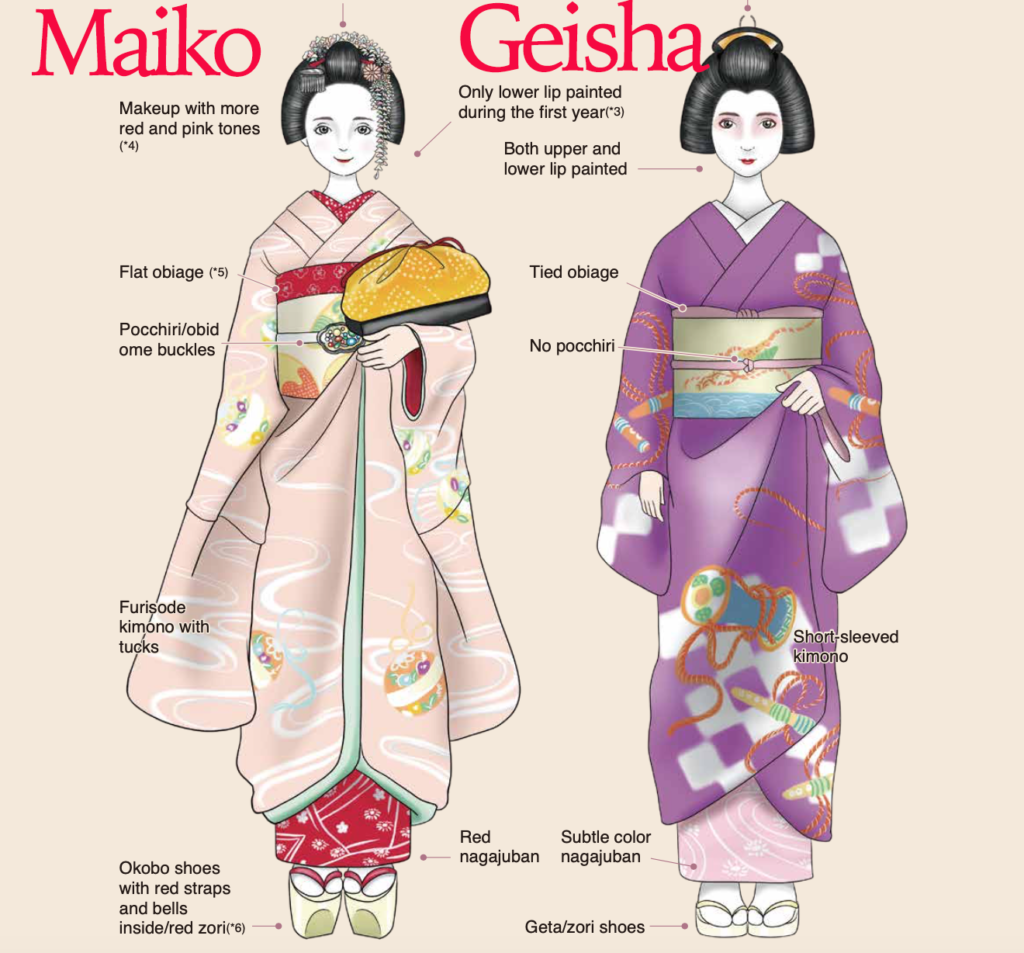 Maiko Geisha Geiko Differences FRONT
Maiko Geisha Geiko Differences FRONT
Meaning of the words Maiko and Geisha
Geisha means the person of arts, and Maiko means the child who dances. The word gei in geisha and gei-ko refers to performing arts. Sha and ko pretty much have the same meaning in this context: which means a person. Mai means "dance" in Japanese, and -ko in this context refers to a child.
Conversational skills
Since Maiko is still training, she speaks less and usually nods or smiles during a conversation. On the other hand, Geiko is an expert in initiating and maintaining a conversation. Geisha would know what conversations make patrons calm, relaxed, or happy.
Cultural skills
Maiko would attend the dance school every day and practice shamisen playing until she was perfect. Geiko is a professional who can dance, play shamisen, and perform tea ceremonies. The training takes so long because the geisha dance to different themes and songs almost every month as seasons and festivals pass by. In Kyoto, each geisha district specializes in other musical instruments and tea ceremony styles. So, it is not true that all geisha could play any instrument.
Age
Maiko is between the ages of 15 and 20, while the geiko is older than 20. In the past, little girls used to be sold to Okiya at the age of 7; since this is now illegal in Japan, many girls enter the Okiya after they complete the mandatory national education requirement, which is junior high school. Even though the typical maiko training is 3~5 years, sometimes the maiko stage can last 7-8 years. So there are Maiko in Kyoto who are older than 20. Readers should note that Maiko only exists in Kyoto; there is no such thing as the maiko stage in the other geisha districts.
The traces of young girls' becoming Maiko can still be seen in the outfits of Maiko today. For instance, Maiko usually wears a sash that shows a huge crest of the okiya they belong to. Mark is huge because, in the past, these little girls used to get lost, and people could have brought them back to the houses they belonged to by recognizing the crest.
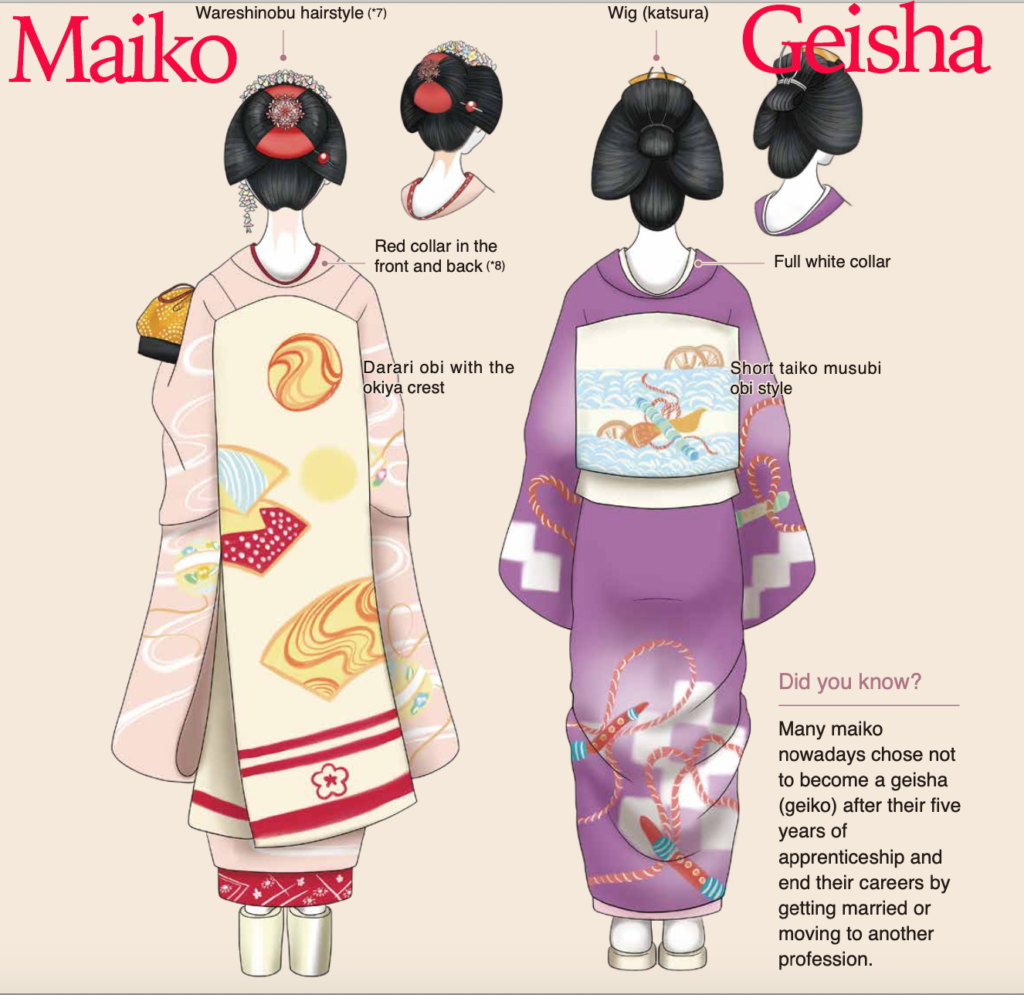 Maiko Geisha Geiko Differences BACK
Maiko Geisha Geiko Differences BACK
Appearance
Geiko usually has simple, elegant, and sophisticated looks reflecting maturity and wisdom. Maiko's outfit is colourful and vibrant, showing her youth and purity.
White Powder on the face
First of all, contrary to the common belief, neither geiko nor Maiko wear white makeup all the time; however, when they do, there are differences. Geiko would have a completely white face, while Maiko has a little space between the hairline and white powdered skin. Geiko and Maiko put on white makeup to be seen clearly in the dark room, as there was no electricity in the past.
Lips
Geiko colours both of her lips red while Maiko, especially junior Maiko, only the lower lip red. Senior and junior Maiko have different lip makeup patterns.
Red around the eyes
Maiko have distinctive red makeup around the eyes, while this redness is less emphasized for geiko. The red makeup around the eyes is often tied to the kabuki tradition, which often uses white, red, and black colours to be visible to the audience members who may be watching from a distance.
Pink Blush
Maiko has some pink blush, while the geiko doesn't. The idea is that Maiko always looks young and pure.
Wig
Maiko, don't wear a wig. They have to have their hair styled, which costs time and money. Maiko often sleep on a piece of wood (takamakura) at night to keep their hairstyle for a few days. Geiko wears wigs as the styling usually damages the hair over time, and ageing makes it a bit oily and challenging to maintain.
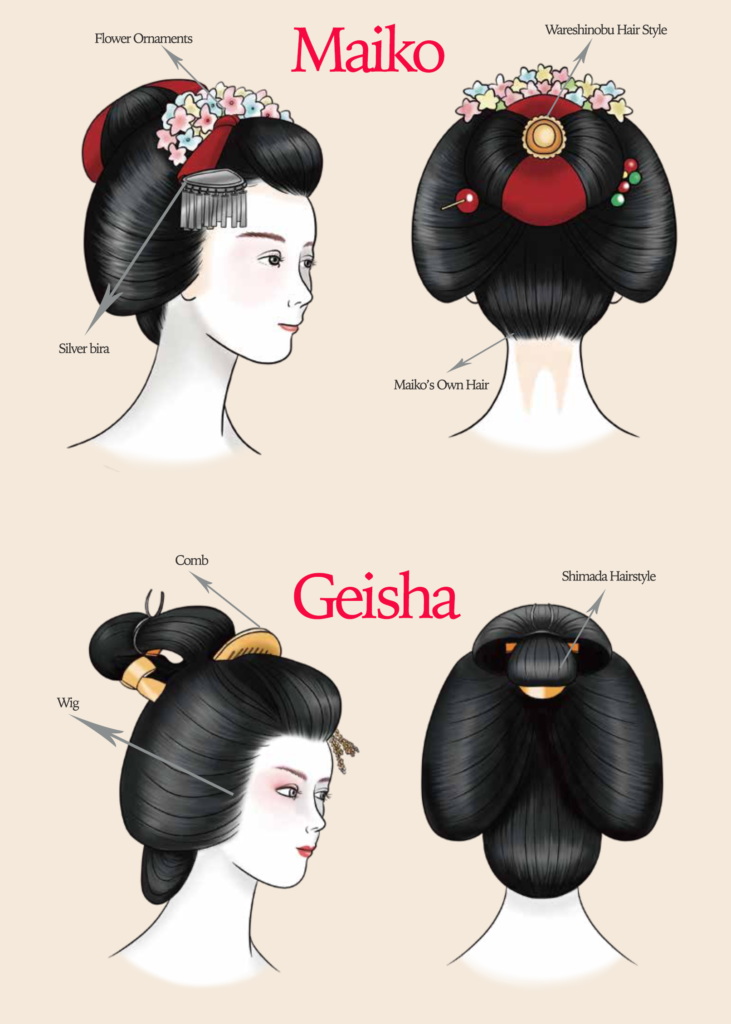 Maiko Geisha Geiko Differences HAIRSTYLES
Maiko Geisha Geiko Differences HAIRSTYLES
Hair Styles
The hairstyle is one of the most significant differences between a maiko and a geiko. As clearly visible in the illustrations, the Maiko has the wareshinobu hairstyle while the geiko has the shimada hairstyle. Senior and junior Maiko have different hairstyles. Maiko wears colourful hair ornaments with flower motifs, which change every month. Geiko does not wear hair ornaments except a simple comb.
Hairpins
Maiko wears silver dangling metal hairpins called bira. Geiko usually doesn't wear hairpins or uses straightforward ones.
Kimono
The images show that Maiko wears a colourful, usually flower-decorated, kimono with long sleeves, while Geiko wears a simple kimono with short sleeves. The innerwear of Maiko and geiko are also different, as illustrated above. To emphasize the young age and purity of the Maiko, the chest of the Maiko is generally suppressed. Both Maiko and geiko wear expensive silk kimonos that are always tailor-made and not sold in stores.One of the main differences between Maiko and geiko is the collar colour they wear. Maiko wears a red collar, and Geiko wears a white collar. That is why, when a maiko becomes a professional geiko, they use the term "turning the collar." Read More about the kimono of Maiko and geisha.
Sash (Obi)
Maiko wears a long silk sash that is 5~7 meters long. Geiko wears a simple short belt. Maiko's outfit can be as heavy as 15 kilos in the winter with the long strap, the complicated innerwear, and the jacket.
Sandals
Maiko wears tall sandals called kobo, and Geiko wears short sandals called zori. Maiko's sandals usually have a bell that sounds when they move. Although the sounds of these little bells may make them look childish, this is called the sound of Kyoto streets among the locals.“When the new Maiko makes a mistake, she may be surprised, then ashamed, to find that her older sister will apologize to others. She learns.” ― Liza Dalby (Geisha, 25th Anniversary Edition)
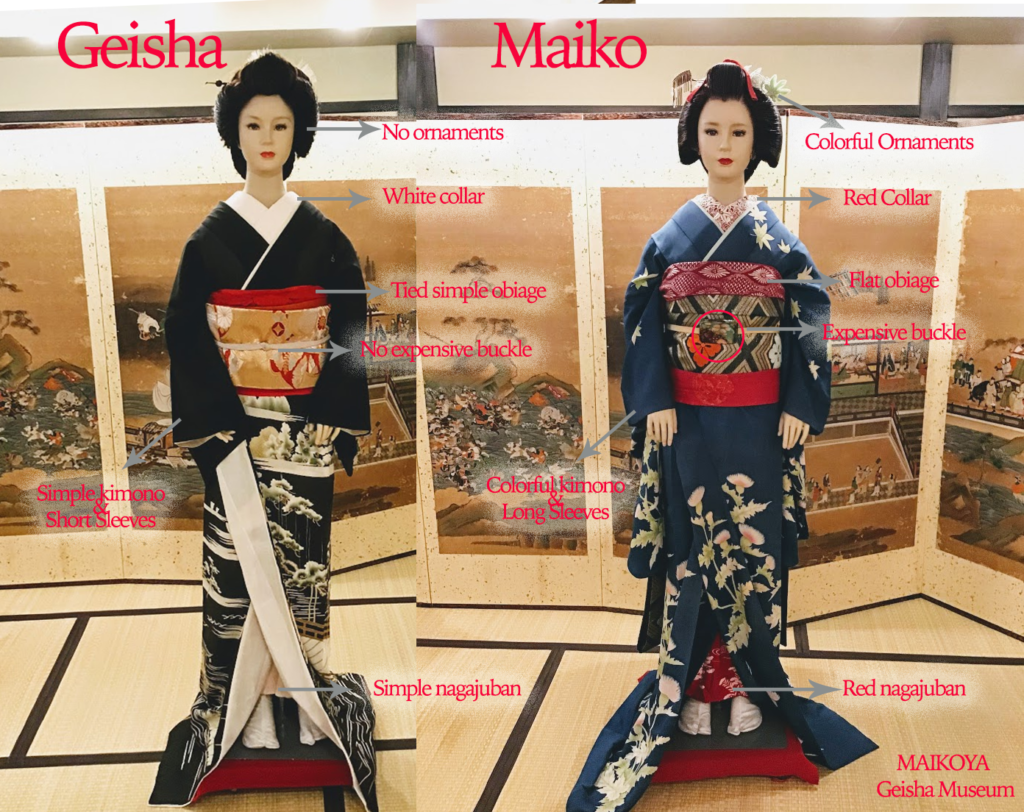 Maiko Geisha Geiko Differences at Maikoya Geisha Museum
Maiko Geisha Geiko Differences at Maikoya Geisha Museum
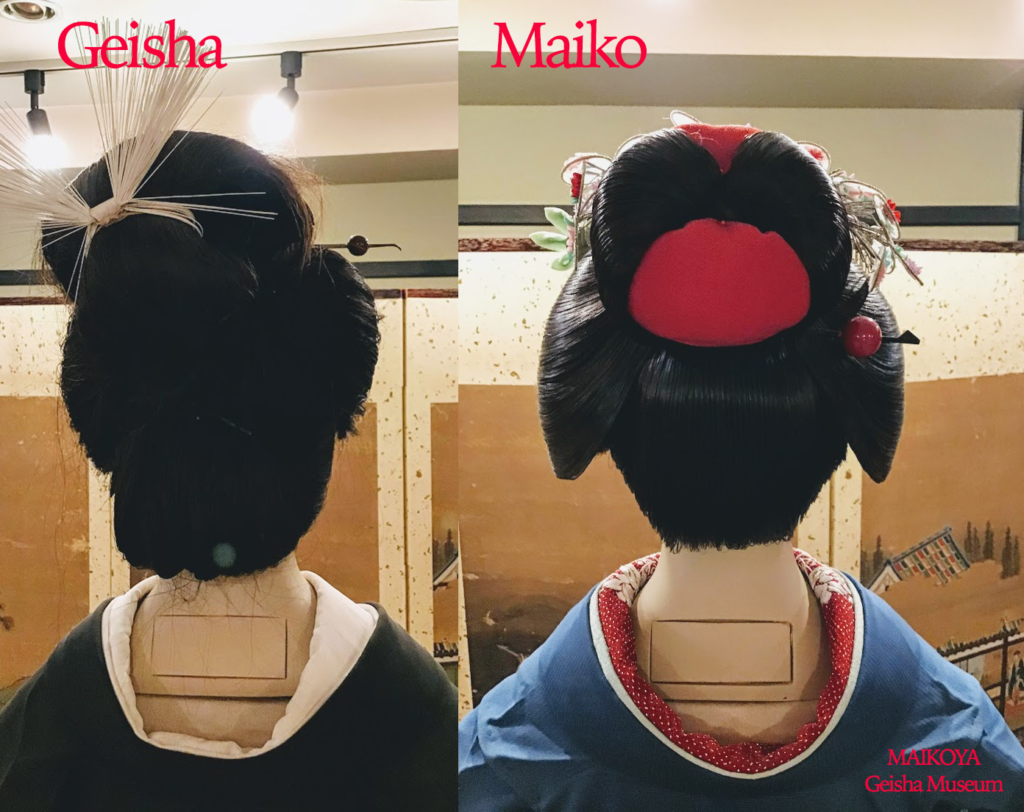 Maiko Geiko Geisha Hairstyles from back Geisha Museum
Maiko Geiko Geisha Hairstyles from back Geisha Museum
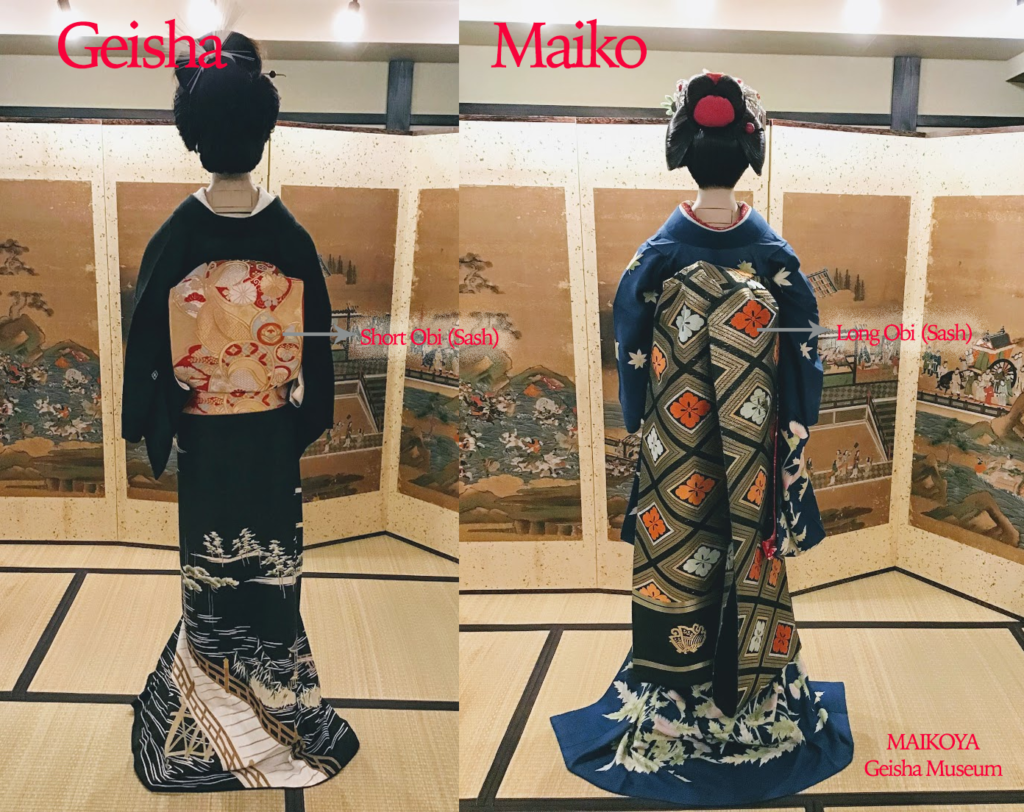 Maiko Geiko Geisha Back Geisha Museum
Maiko Geiko Geisha Back Geisha Museum
BACK TO Geisha Experience Reservation Page
FAQs
How to Become a Geisha?
To become a geisha, the first step is to apply and be accepted into an okiya, where one can undergo training as a maiko before becoming a geisha. Traditionally, geisha are women of Japanese origin, although it is still possible, just not typical, for foreigners to be accepted for training.
How do Geisha sleep?
Maiko would often be trained to sleep using a Takamura as a pillow to maintain their hairstyle. While geiko or geisha would sometimes do the same, some opt to use a wig because the hairstyle often damages the natural hair over time.
How do I hire a Geisha?
There are many geisha experiences around Kyoto, especially from the Kyoto Maikoya Tea Ceremony, where visitors can see geikos or maikos perform through a virtual meeting or a private session in person.
Why do Geisha have black teeth and white makeup?
Geiko and Maiko put on white makeup to be seen clearly in the dark room, as there was no electricity in the past. The black teeth or "Ohaguro" is a practice observed to show someone has come of age or become an adult, and provides an attractive contrast to the white makeup. Although the course has died out, some geishas still dye their teeth in Kyoto.
Are Geishas respected in Japan?
Geishas are highly respected artists and performers in Japan; it is a long and challenging process to become one, especially in Kyoto, where the traditions are strictly observed.










